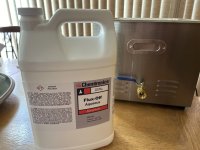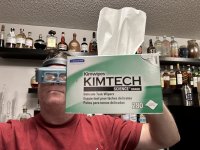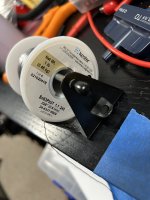Thought I would share a couple of things for other beginners;
1. A very inexpensive and useful tool is a lead bender. These can save a lot of time and enhance the look of your build.
2. My first few builds were done w/out flux On my current build I began w/out and then started using it, far superior results w/.
On my current build I began w/out and then started using it, far superior results w/.
I said a couple, but the use of flux does require flux cleaner, I'm looking at options but @poseidonsvoice has suggested Chemtronics as well as his OCD method in this post
method in this post
Lastly double and triple check as you go, fixing mistakes is at best time consuming and at worst can ruin a part.
1. A very inexpensive and useful tool is a lead bender. These can save a lot of time and enhance the look of your build.
2. My first few builds were done w/out flux
 On my current build I began w/out and then started using it, far superior results w/.
On my current build I began w/out and then started using it, far superior results w/.I said a couple, but the use of flux does require flux cleaner, I'm looking at options but @poseidonsvoice has suggested Chemtronics as well as his OCD
Lastly double and triple check as you go, fixing mistakes is at best time consuming and at worst can ruin a part.
Great thread starter... watching.
My imagination, paranoia, and experience err a bit more to the side of worse outcomes... I'm both serious and ribbing you a bit. Fires and electric shock / death are very real possibilities.
Your main point of double and triple checking things is 100% valid; however the consequences can be more dire. All beginners (really all DIYers) should be aware and accept the realities along with reading up on electrical safety.
My experience of learning through this forum and other sources has been absolutely wonderful. However, I must admit that I've had a few moments where my glutes tightened... and thought to myself how lucky I had been.
Thanks for starting the thread.

Emphasis added to your quote is mine...Lastly double and triple check as you go, fixing mistakes is at best time consuming and at worst can ruin a part.
My imagination, paranoia, and experience err a bit more to the side of worse outcomes... I'm both serious and ribbing you a bit. Fires and electric shock / death are very real possibilities.
Your main point of double and triple checking things is 100% valid; however the consequences can be more dire. All beginners (really all DIYers) should be aware and accept the realities along with reading up on electrical safety.
My experience of learning through this forum and other sources has been absolutely wonderful. However, I must admit that I've had a few moments where my glutes tightened... and thought to myself how lucky I had been.
Thanks for starting the thread.

^ Not disagreeing, but I've found that even the seemingly only a tad higher concentrations of 99%+ to be anecdotally much more effective for the types of fluxes / solder + resin/flux I typically use. Absolutely use 90% if that's what you have around, and don't necessarily buy a new bottle just for cleaning boards, but if I were buying a new bottle, and if it were easily available to me... I'd use something closer to 99%.
Note - It's hyg(d)roscopic, so leave the cap on... or it will lower in concentration easily... and note that it's flammable.
It can be picked up locally at various hardware / drug stores / discount stores or online retailers.
Note - It's hyg(d)roscopic, so leave the cap on... or it will lower in concentration easily... and note that it's flammable.
It can be picked up locally at various hardware / drug stores / discount stores or online retailers.
In addition to double/triple checking your work, it is helpful to perform functional tests at logical stages of construction.
For example, I start building the power supply first, and perform tests at several points. The first is after wiring up the line AC, fuse, power switch and transformer. Next is testing after the rectifier is connected, and then after the filter components are added. Then, I connect a load resistor (after calculating resistance for the design current) and verify that the power supply is functioning properly. Using a variac or dim bulb circuit is helpful for minimizing jitters when doing these tests.
I continue performing functional testing for the rest of the construction at different points, so that problems are discovered early and are easily corrected. If you leave all the testing until the end, the trouble shooting process is more complicated and you may have to disassemble your work to isolate the problem. The worst case would be damaged components.
For example, I start building the power supply first, and perform tests at several points. The first is after wiring up the line AC, fuse, power switch and transformer. Next is testing after the rectifier is connected, and then after the filter components are added. Then, I connect a load resistor (after calculating resistance for the design current) and verify that the power supply is functioning properly. Using a variac or dim bulb circuit is helpful for minimizing jitters when doing these tests.
I continue performing functional testing for the rest of the construction at different points, so that problems are discovered early and are easily corrected. If you leave all the testing until the end, the trouble shooting process is more complicated and you may have to disassemble your work to isolate the problem. The worst case would be damaged components.
^ I like this method A LOT...I've been using 99.9% IPA. Manual brush and a kids electric toothbrush (Paw Patrol!) and compressed air. And I have an ultrasonic cleaner when I really mean it, and feeling ambitious..

Also... for those particularly stubborn areas on the back of the through-hole board...
I saturate a KimWipe (or similar), wad it up to save my fingertips, and scrub over a trash can. A few passes will leave even the nastiest of boards sparking in my experience with no residue or linty mess.
Edited to add -
"And I have an ultrasonic cleaner when I really mean it, and feeling ambitious..."
I've found this stuff particularly wonderful.... FWIW...

Last edited:
What's all this talk of flux and cleaning?
I love my Kester 245 No-Clean 63/37 solder.
100% agree on double/triple checking. I also solder one side of board and check all the connections on the other side for touchup. This helps prevent cold/bad connections.

I love my Kester 245 No-Clean 63/37 solder.
100% agree on double/triple checking. I also solder one side of board and check all the connections on the other side for touchup. This helps prevent cold/bad connections.
Kimtech Kimwipes... a true techno nerd will have a box of those nearby, probably.. a set of OptiVisors on your head...etc.
HEY!!!!!????
I resemble that remark.

Note for beginners... best not to have the workbench so close the bar...
Attachments
Oh wow. I've not heard of Kimtech wipes so I'll have give them a try.
Don't laugh, but recently I soldered a small board which only had SMD resistors and caps. It was covered with a lot of flux so on a lark I 'cleaned' the board with Pert shampoo and an old toothbrush.
Of course, I've have tried using the board so I don't know if my 'cleaning regiment' that might have damaged it.
Don't laugh, but recently I soldered a small board which only had SMD resistors and caps. It was covered with a lot of flux so on a lark I 'cleaned' the board with Pert shampoo and an old toothbrush.
Of course, I've have tried using the board so I don't know if my 'cleaning regiment' that might have damaged it.
@Dennis Hui - Use a two-in-one to provide extra 'volume'...
Back to our regularly scheduled programming...
Back to our regularly scheduled programming...
Uh, if its good enough for Randy, its worth a try.I love my Kester 245 No-Clean 63/37 solder.
^ FWIW, I also think it's a wonderful choice. The 0.025" (IMO) is a perfect 'in-between' diameter for just about all applications. Flows great etc. If I only had one spool of solder on the bench, this may be it. This is the second spool I've purchased in 3 years..
I also can't recommend the Fire Metall from the store highly enough. Makes gorgeous shiny joints and flows like a dream. My only tiny wish is that it also came in various diameters. Wonderful stuff.
I also can't recommend the Fire Metall from the store highly enough. Makes gorgeous shiny joints and flows like a dream. My only tiny wish is that it also came in various diameters. Wonderful stuff.
Attachments
Never been a fan of IPAs; im more of a stout guyI've been using 99.9% IPA. Manual brush and a kids electric toothbrush (Paw Patrol!) and compressed air. And I have an ultrasonic cleaner when I really mean it, and feeling ambitious..
Even more helpful if accompanied by a relevant link:...A very inexpensive and useful tool is a lead bender. These can save a lot of time and enhance the look of your build.
https://probemaster.com/speedy-bend-resistor-lead-forming-tool/
- Home
- Amplifiers
- Pass Labs
- Journey Of A Novice DIYer

